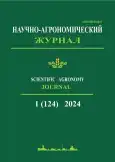Soil and Floral Indicators of Eroded and Desolate Landscapes of Republic of Buryatia
- Authors: Altaev A.A.1, Biltuev A.S.1, Ulanov A.K1, Dregval S.N1, Budazhapov L.V1, Khutakova S.V.2
-
Affiliations:
- Buryat Research Institute of Agriculture – branch of SFSCA RAS
- Buryat State Agricultural Academy named after V.R. Philippov
- Issue: No 1(124) (2024)
- Pages: 19-25
- Section: Agroforestry Amelioration
- URL: https://journals.rcsi.science/2500-0047/article/view/304018
- DOI: https://doi.org/10.34736/FNC.2024.124.1.002.19-25
- ID: 304018
Cite item
Full Text
Abstract
The desiccated and eroded landscapes of Buryatia that have developed during natural and anthropogenic transformation are actually little used for agricultural needs due to their extremely low yields. The study of such landscapes in recent years has been very relevant in the context of the global aridization of the Earth’s climate and the need to increase the agricultural land productivity. The purpose of the presented study is to identify the soil–botanical parameters of the indication of agricultural and natural landscapes desertification. The novelty of this work is in the complexity of studies of degraded landscapes of the region with detailed soil and agrochemical analysis taking into account the geobotanical features of the studied polygons. 6 desertification research sites were laid on 4 test sites on the territory of Buryatia. The geobotanical and soilagrochemical data from the survey of desertification sites analysis showed a variety of soil and plant complexes. The results highlighted the reliability of soil and plant indicators of soil degradation. At the same time, local plant species can act as a kind of natural biotic barrier to the sands onset in Buryatia. The scientific and practical significance of this study is expressed in updating the current state of the desertification processes long-term study polygons in Western Transbaikalia. The information received will serve as a starting point for stationary and remote studies of desertification in the region within the framework of the project on the national action programs to combat desertification in the Republic of Buryatia development.
About the authors
A. A. Altaev
Buryat Research Institute of Agriculture – branch of SFSCA RAS
Email: altaev@mail.ru
Russian Federation, Tretyakova St. 25z, Ulan-Ude
A. S. Biltuev
Buryat Research Institute of Agriculture – branch of SFSCA RAS
Email: altaev@mail.ru
Russian Federation, Tretyakova St. 25z, Ulan-Ude
A. K Ulanov
Buryat Research Institute of Agriculture – branch of SFSCA RAS
Email: altaev@mail.ru
Russian Federation, Tretyakova St. 25z, Ulan-Ude
S. N Dregval
Buryat Research Institute of Agriculture – branch of SFSCA RAS
Email: altaev@mail.ru
Russian Federation, Tretyakova St. 25z, Ulan-Ude
L-Z. V Budazhapov
Buryat Research Institute of Agriculture – branch of SFSCA RAS
Email: altaev@mail.ru
д.б.н., член-корр. РАН
Russian Federation, Tretyakova St. 25z, Ulan-UdeS. V. Khutakova
Buryat State Agricultural Academy named after V.R. Philippov
Author for correspondence.
Email: altaev@mail.ru
Russian Federation, Pushkina St. 8, Ulan-Ude
References
- Altaev A. A., Namzalov B. B.-M., Biltuev A. S. On floral indicators of Western Transbaikalia eroded and desolate landscapes // Vegetation of the Baikal region and adjacent territories: materials of the All-Russian conference with international participation (Ulan-Ude, October 26–27, 2023). Ulan-Ude: Buryat State University, 2023. Pp. 93–97. (In Russ.) doi: 10.18101/978-5-9793-1877-6-1-176.
- Biltuev A. S., Lapukhin T. P., Budazhapov L. V. Climate, soil fertility and productivity of grain crops in the dry steppe of Buryatia. Ulan-Ude: Buryat State Agricultural Academy named after V. R. Philippov, 2014. 101 p. (In Russ.)
- Dulepova N. A., Korolyuk A. Y. Vegetation of fluttering sands and sandy steppes of the Selenga River basin lower part (Republic of Buryatia) // Rastitel’nost’ Rossii = Vegetation of Russia. St. Petersburg, 2015. No. 27. Pp. 78–95. (In Russ.)
- The UN Convention to Combat Desertification. The BWC Framework Strategy for 2018–2030. 2018. [Web resource] URL: https://www.unccd.int/sites/default/files/relevant-links/2018-08/cop21add1_SF_RU.pdf (access date: 08.10.2023).
- Namzalov B. B., Baskhaeva T. G. Spatial organization of the Barguzin depression mountainous forest-steppe vegetation (Northern Near-Baikal region) // Turczaninowia. 2018. Vol. 21, No. 1. Pp. 52–65. (In Russ.) doi: 10.14258/turczaninowia.21.1.7.
- Namzalov B.-Ts. B. Buryatia – the land of plant paradoxes. Barguzin Valley // Vestnik Buryatskogo gosudarstvennogo universiteta. Biologiya, geografiya. 2020. No. 2. Pp. 58–65. (In Russ.) doi: 10.18101/2587-7148-2020-2-58-65.
- National report "Global climate and soil cover of Russia: desertification and land degradation: manifestations of drought, measures of prevention, control, elimination of consequences and adaptation measures (agriculture and forestry)" / Ed. by R. S.-Kh. Edelgeriev. Moscow: IBA, LLC, 2021. Vol. 3. 700 p. (In Russ.)
- Determinant of plants of Buryatia / Ed. by O. A. Anenkhonov. Ulan-Ude: Institute of General and Experimental Biology RAS, 2001. 672 p. (In Russ.)
- Regional report on the state and use of land in the Republic of Buryatia in 2021. Ulan-Ude: Department of the State Register of the Russian Federation for the Republic of Buryatia, 2021. 80 p. (In Russ.)
- Sakhyaeva A. B., Namzalov B.-Ts. B. Artemisia sieversiana Willd. (Asteraceae) cenocomplex in the fallow vegetation of the Upper Kuitun (Barguzin Valley, Republic of Buryatia) // Izvestiya Irkutskogo Gosudarstvennogo Universiteta. Seriya Biologiya. Ecologiya = The Bulletin of Irkutsk State University. Series: Biology. Ecology. 2018. No. 25. Pp. 32–40. (In Russ.) doi: 10.26516/2073-3372.2018.25.32.
- Sub-regional action program to combat desertification for the Republic of Buryatia, the Aginsky Buryat Autonomous Okrug and the Chita Region / Team of authors. Ulan-Ude, 2000. 168 p. (In Russ.)
- Shchipek T., Vika S., Snytko V. A., Ovchinnikov G. I., Namzalov B.-Ts. B., Dambiev E. Ts. Mankhan-Elysu Aeolian tract in Transbaikalia. Irkutsk – Ulan-Ude: Buryat State University, 2005. 62 p. (In Russ.)
Supplementary files







